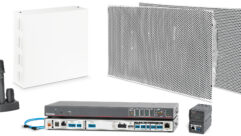Can You Hear Me Now?
Addressing Noise in the Classroom
Aug 16, 2006 12:51 PM,
By Linda Seid Frembes
For roughly eight months out of every calendar year, the classroom is the central place of learning for both K-12 and university students. For those who have not experienced a classroom lesson since leg warmers were fashionable, memory has polished the experience to one that consists of well-behaved, silent students sitting in their seats and raptly listening to their teacher read from a lesson plan. Not so in today’s learning environment, where ambient noise from computers, projectors, and small group conversation often dominates the classroom atmosphere.
According to a 1998 report in The Journal of the American Medical Association (JAMA), nearly 15 percent of children from ages six to 19 have some degree of hearing loss in one or both ears. Coupled with modern-day noise in the classroom, speech intelligibility becomes an important factor to consider in the learning process.
Recently, the Acoustical Society of America (ASA) issued a policy statement that caught the eye of many AV professionals and audio manufacturers in particular. Titled “Acoustical Society of America Position on the Use of Sound Amplification in the Classroom,” the position statement advises schools not to use sound amplification systems in their efforts to overcome noisy conditions in classrooms.
“We are supportive of the ASA stance,” notes Gregory C. Tocci, president and founding partner of Cavanaugh Tocci Associates, a consulting firm in Sudbury, Mass. “The weakness of using only electroacoustic systems is brought out in the ‘channels of communication’ segment of the statement.”
The succinct document points out, “There are three channels for speech communication in classrooms: (1) student-to-student, (2) student-to-teacher, and (3) teacher-to-student.”
Tocci explains that electroacoustic systems enhance the teacher-to-student communication channel, while the others remain unimproved. “Complete communications must involve all three channels,” he adds.
Classroom design has become a cookie-cutter process due to cost-cutting pressures unseen in other markets—thus creating the recipe for poor acoustics as ambient noise levels continue to rise. According to Tocci, acoustical problems result when certain cost-savings measures are implemented prior to construction. “Often, more quiet central HVAC systems are downgraded to a cabinet unit in the classroom, which creates an environment where background noise is a source of distraction,” he said. “Secondly, sound-absorptive treatment is taken out of the budget because the thought is that it can always be added in later. Finally, certain construction techniques may enhance sound transmission from classroom to classroom.”
Classroom sound systems
Recent developments in the audio market have produced an increase in classroom-specific audio systems to address speech intelligibility strictly from an electroacoustic design perspective. “The ASA has done a good job working with architects to develop standards for the industry and improving other aspects pertaining to the field of acoustics,” says Tim Ridgway, vice president of marketing for Califone, a manufacturer of audio systems for professional and education use. “Simply installing an audio system to make a room louder does not automatically benefit students. The audio system must not greatly contribute to the ambient field of noise.”
Ridgway points to the use of array technology by Califone that targets a focused coverage pattern directly at the students, rather than bouncing sound off the walls. “Many other packaged systems have wider sound patterns that are not appropriate for the classroom,” he notes. “I can see why the ASA felt the need to make that statement. However, based on research studies and the development of our technology, we are comfortable that our system is truly assisting the students.”
The most noted study on the relationship between noise and learning is the original “Mainstream Amplification Resource Room Study” (MARRS) conducted between 1978 and 1981. In the study, a sound system was used to amplify the teacher’s voice above background noise so that students in the back row could hear as clearly as those in the front row. According to the study, “The MARRS Project was primarily intended as a means of helping students with mild or minimal fluctuating hearing losses compensate for poor classroom acoustics enabling them to remain in the mainstream without expensive referral and identification procedures.”
The study also states, “Almost all students comment the amplified voice helps them pay attention, better understand oral directions, shut out distracting noises, and hear the teacher without straining.” Subsequent studies based on the MARRS model have produced similar results.
An issue of cost
In an ideal world, the solution to acoustical problems would occur in the architectural design phase rather than post-construction. In the real world, most classrooms were built decades ago, and ever-tightening school budgets mean that the most cost-effective solution has to be the best. In the conversation of addressing acoustics versus installing a sound system, the cost comparison is not an evenly matched fight. According to Tocci, sound absorption materials can cost anywhere from $3 per square foot to upwards of $10 per square foot. He adds, “As a general rule, you need at least as much as the floor area since you are addressing both the ceiling and the walls.”
In contrast, Califone’s Classroom Infrared System (Model P130-IRSYS) to cover one classroom costs $950. “There is a place for sound systems in the classroom, but it’s not a be-all end-all solution.” says Tocci. “For a long-term solution to be effective, you must address all three channels of communication.”










